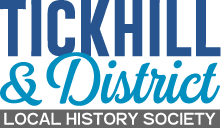

Trades and Professions in Tickhill
Tickhill is included in many trade directories produced in the 19th and 20th Centuries. Typically, the entries give a very brief review of local history before providing useful listings, ranging from times when the post is collected to the names of the principal residents and who was involved in particular trades or professions. By comparing directory entries from 1837 and 1915, when the population was increasing towards 2,000 each side of declining numbers in the second half of the 19th Century, it is possible see what changed and what degree of continuity there was in local people’s way of life.
Some occupations existed in 1837 but were no longer recorded in 1915: baker, brazier (brass worker), brick and tile maker, cooper, excise officer, female pill manufacturer (that is, pills for females!), glass dealer, hedge carpenter, huckster (small goods trader), leather cutter, lime burners, linen manufacturer and bleacher, maltsters, nail manufacturers, paper maker, plasterer, printer and bookseller, rope maker, sacking manufacturer, saddlers, tanner and, finally, workhouse governess. Where goods represented by many of the trades were needed in 1915, they would have been obtained from outside Tickhill, although in the case of bakers, it is possible that some people listed as shopkeepers in 1915 also baked bread. In contrast, the following trades or places of work existed in 1915 but were not recorded in 1837: bicycle dealer, broker, building firm, chimneysweep, collectors of rates and market tolls, dealers in eggs, hay and potatoes, dress makers, gamekeeper, gas light company manager, insurance agent, lodging house, market gardener, motor garage, photographer, poultry dealer and fishmonger, refreshment room, surveyor, threshing machine proprietor, tinsmith, and veterinary surgeon. Some of these trades clearly reflect technological progress since 1837. The 1915 Directory also listed the Urban District Council members, two banks (each open only on Thursdays from 9.30 a.m. to 11.30 a.m.) and organisations such as Friendly Societies, the Conservative Club and the Public Library.
Where there were similar occupations in both years, the following list shows respective numbers:
| 1837 | 1915 | |
|---|---|---|
| Farmers/farm bailiff | 38 | 36 |
| Butchers | 6 | 7 |
| Grocers/shopkeepers | 15 | 10 |
| Confectioners | 1 | 2 |
| Millers | 3 | 1 |
| Inn keepers | 7 | 5 |
| Beer retailers | 7 | 3 |
| Boot/Shoemakers | 9 | 2 |
| Tailors/drapers | 5 | 2 |
| Milliners/straw hat makers | 8 | 2 |
| Hairdressers | 3 | 1 |
| Watchmaker | 1 | 1 |
| Gardener | 1 | 3 |
| Stonemasons | 6 | 3 |
| Blacksmiths | 6 | 3 |
| Wheelwrights | 8 | 1 |
| Carpenters/joiners | 6 | 3 |
| Plumbers/glaziers | 3 | 4 |
| Carters/carriers | 4 | 3 |
| Teachers | 7 | 10 |
| Chemists/druggists | 2 | 1 |
| Surgeons/doctors | 3 | 2 |
| Attorneys | 2 | 2 |
| Clergymen | 2 | 1 |
| Post mistress | 1 | 1 |
The reduction in the number of people undertaking certain trades by 1915 suggests, for example, that local shops were importing ready made goods such as clothes, hats and shoes. The decline in the numbers of blacksmiths and wheelwrights is a sign of the change to motorised vehicles. Very few women were listed in trades or professions in either year.